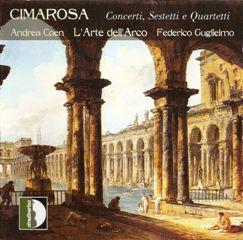Cimarosa – Concerti, Sestetti e Quartetti
Cimarosa – Concerti, Sestetti e Quartetti

CD1 1 Harpsichord Concerto in B flat major: [Allegro] 2 Harpsichord Concerto in B flat major: Recitativo - Allegro moderato, andante - Aria. Largo 3 Harpsichord Concerto in B flat major: [Rondò] 4 Concerto for 2 flutes & orchestra in G major: [Allegro] 5 Concerto for 2 flutes & orchestra in G major: [Largo] 6 Concerto for 2 flutes & orchestra in G major: Allegretto ma non tanto 7 Quartet for flute, violin, viola & cello No. 1 in D major: Allegro moderato 8 Quartet for flute, violin, viola & cello No. 1 in D major: Adagio 9 Quartet for flute, violin, viola & cello No. 1 in D major: Rondeau 10 Quartet for flute, violin, viola & cello No. 3 in D major: Allegro 11 Quartet for flute, violin, viola & cello No. 3 in D major: Adagio 12 Quartet for flute, violin, viola & cello No. 3 in D major: Tempo di menuetto 13 Quartet for flute, violin, viola & cello No. 5 in D major: Andante con variazioni 14 Quartet for flute, violin, viola & cello No. 5 in D major: Menuetto 15 Quartet for flute, violin, viola & cello No. 5 in D major: Rondo CD2 1 Sextet for keyboard, 2 violins, viola, cello & bassoon in G major: Allegro maestoso 2 Sextet for keyboard, 2 violins, viola, cello & bassoon in G major: Siciliana. Largo ma non tanto 3 Sextet for keyboard, 2 violins, viola, cello & bassoon in G major: Rondò. Allegro vivace con gusto 4 Sestetto for keyboard, harp, violin, viola da gamba, cello & bassoon in F major: Largo non tanto. Allegro maestoso 5 Sestetto for keyboard, harp, violin, viola da gamba, cello & bassoon in F major: Largo cantabile 6 Sestetto for keyboard, harp, violin, viola da gamba, cello & bassoon in F major: Rondò. Allegro giusto 7 Quartet No. 2 for Oboe & Strings in G major: Adagio 8 Quartet No. 2 for Oboe & Strings in G major: Minuetto e trio 9 Quartet No. 2 for Oboe & Strings in G major: Finale 10 Quartet for flute, violin, viola & cello No. 4 in F major: Allegro moderato 11 Quartet for flute, violin, viola & cello No. 4 in F major: Andante 12 Quartet for flute, violin, viola & cello No. 4 in F major: Allegro 13 Quartet for flute, violin, viola & cello No. 6 in A minor: Allegro 14 Quartet for flute, violin, viola & cello No. 6 in A minor: Adagio 15 Quartet for flute, violin, viola & cello No. 6 in A minor: Finale Andrea Coen – Fortepiano Mara Galassi – Harp Vittorio Ghielmi - Viola da Gamba Marta Mazzini - Transverse Flute Paolo Pollastri – Oboe L'Arte dell'Arco Frederico Guglielmo – Director, Violin
A composer who was quite familiar to Mozart's operatic audiences, Domenico Cimarosa was the prolific creator of over 60 operas. He was the son of a poor bricklayer, coming from a working-class family. He studied music at the Conservatorio Santa Maria di Loreto from 1761 until 1772. Among his teachers was the famous Piccinni, the rival of Gluck in France. His first opera was Le stravaganza del conte. It premiered in Naples in 1772, and its success was such that it brought Cimarosa immediate recognition. Cimarosa spent the next several years in Rome and Naples, and composed over twenty operas for these two cities. His operas were performed internationally in Paris, Vienna, Dresden, and London. In 1787, Catherine II invited him to St. Petersburg. During his stay in Russia, Cimarosa continued to compose at a prodigious rate. La Cleopatra and La vergine del sole are two works that were staged in 1788. Subsequently, Leopold II of Austria engaged him as court Kapellmeister in Vienna, to fill the position vacated by Salieri. One of Cimarosa's greatest successes was staged in Vienna. Il matrimonio segreto, a delightful comic opera full of invention and wit, immensely pleased the Emperor. He gave the entire cast supper, and had them perform the entire opera again that same evening. Although lacking Mozart's depth, Cimarosa's music does possess some of Mozart's qualities -- in particular, a gift for the comic, buffo style.
After the death of the Emperor, Salieri was reappointed Kapellmeister, and Cimarosa was released. He left Vienna and returned to Naples where he entered the service of the King. He was hailed in Naples as a great operatic hero, and his Il matrimonio segreto was performed 57 times running. However, Cimarosa's last years were marked by misfortune. When the French Republican army marched into Naples, Cimarosa enthusiastically declared his support of the revolution. He was immediately thrown into prison and condemned to death. The King eventually released him, but banished him from Naples. Broken in spirit, Cimarosa attempted to return to Russia, but died in Venice in 1801. Because of rumors that he was poisoned, the government was obliged to perform an autopsy. In addition to operas, Cimarosa left behind oratorios, masses, and cantatas, and some instrumental music. --- Rita Laurance, Rovi
download:








